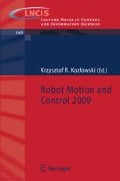Introduction
Robot simulators give many opportunities for development of new control algorithms. They are particularly useful for improvement of control strategies by means of learning. Motivation to use a simulator for learning such robot behaviors like gaits in walking robots stems from the fact that the trial-and-error learning on a real robot may be dangerous. Also, the number of simulated runs performed in the given amount of time can be much higher than the number of real experiments. However, any simplification made in a simulator may be exploited by the learning algorithm, resulting in a gait pattern, which cannot be reproduced on the real robot. This “reality gap” problem has been widely discussed in the literature [5, 9].
Access this chapter
Tax calculation will be finalised at checkout
Purchases are for personal use only
Preview
Unable to display preview. Download preview PDF.
References
Annunziato, M., Pizzuti, S.: Adaptive parameterization of evolutionary algorithms driven by reproduction and competition. In: Proc. ESIT, Aachen, Germany, pp. 325–329 (2000)
Belter, D., Kasiński, A., Skrzypczyński, P.: Evolving Feasible Gaits for a Hexapod Robot by Reducing the Space of Possible Solutions. In: Proc. IEEE/RSJ Int. Conf. on Intelligent Robots and Systems, Nice, France, pp. 2673–2678 (2008)
Jakobi, N., Husbands, P., Harvey, I.: Noise and the reality gap: The use of simulation in evolutionary robotics. In: Proc. 3rd European Conf. on Articial Life, Granada, Spain, pp. 704–720 (1995)
Kennedy, J., Eberhart, R.C.: Particle swarm optimization. In: Proc. of IEEE International Conference on Neural Networks, Piscataway, Australia, pp. 1942–1948 (1995)
Mataric, M., Cliff, D.: Challenges in evolving controllers for physical robots. Robotics and Autonomous Systems 19, 67–83 (1996)
Perry, M.J., Koh, C.G., Choo, Y.S.: Modified genetic algorithm strategy for structural identification. Automatica 84(8-9), 529–540 (2006)
Smith, R.: Open Dynamics Engine, http://www.ode.org (Cited, 9 January 2009)
Walas, K., Belter, D., Kasiński, A.: Control and environment sensing system for a six-legged robot. Journal of Automation, Mobile Robotics and Intelligent Systems 2(3), 26–31 (2008)
Walker, J., Garrett, S., Wilson, M.: Evolving controllers for real robots: A survey of the literature. Adaptive Behavior 11(3), 179–203 (2003)
Zagal, J.C., Ruiz-del-Solar, J., Vallejos, P.: Back to reality: Crossing the reality gap in evolutionary robotics. In: Prepr. 5th IFAC/EURON Symp. on Intelligent Autonomous Vehicles. CD-ROM, Lisbon, Portugal (2004)
Author information
Authors and Affiliations
Editor information
Editors and Affiliations
Rights and permissions
Copyright information
© 2009 Springer London
About this paper
Cite this paper
Belter, D., Skrzypczyński, P. (2009). Population-based Methods for Identification and Optimization of a Walking Robot Model. In: Kozłowski, K.R. (eds) Robot Motion and Control 2009. Lecture Notes in Control and Information Sciences, vol 396. Springer, London. https://doi.org/10.1007/978-1-84882-985-5_18
Download citation
DOI: https://doi.org/10.1007/978-1-84882-985-5_18
Publisher Name: Springer, London
Print ISBN: 978-1-84882-984-8
Online ISBN: 978-1-84882-985-5
eBook Packages: EngineeringEngineering (R0)

